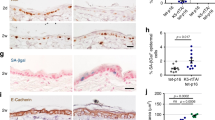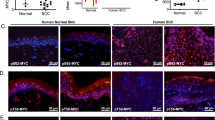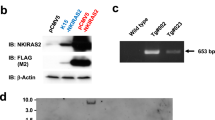Abstract
Activator protein one (AP1) (jun/fos) factors comprise a family of transcriptional regulators (c-jun, junB, junD, c-fos, FosB, Fra-1 and Fra-2) that are key controllers of epidermal keratinocyte survival and differentiation, and are important drivers of cancer development. Understanding the role of these factors in epidermis is complicated by the fact that each member is expressed in defined cell layers during epidermal differentiation, and because AP1 factors regulate competing processes (that is, proliferation, apoptosis and differentiation). We have proposed that AP1 factors function differently in basal versus suprabasal epidermis. To test this, we inactivated suprabasal AP1 factor function in mouse epidermis by targeted expression of dominant-negative c-jun (TAM67), which inactivates function of all AP1 factors. This produces increased basal keratinocyte proliferation, delayed differentiation and extensive hyperkeratosis. These findings contrast with previous studies showing that basal layer AP1 factor inactivation does not perturb resting epidermis. It is interesting that in spite of extensive keratinocyte hyperproliferation, susceptibility to carcinogen-dependent tumor induction is markedly attenuated. These novel observations strongly suggest that AP1 factors have distinct roles in the basal versus suprabasal epidermis, confirm that AP1 factor function is required for normal terminal differentiation, and suggest that AP1 factors have a different role in normal epidermis versus cancer progression.
This is a preview of subscription content, access via your institution
Access options
Subscribe to this journal
Receive 50 print issues and online access
$259.00 per year
only $5.18 per issue
Buy this article
- Purchase on Springer Link
- Instant access to full article PDF
Prices may be subject to local taxes which are calculated during checkout





Similar content being viewed by others
Abbreviations
- TRE or TetO:
-
tetracycline response element
- TAM67:
-
dominant-negative c-jun
- K1:
-
keratin 1
- K14:
-
keratin 14
- K5:
-
keratin 5
- rTA:
-
tetracycline-responsive activator protein
- TPA:
-
12-O-tetradecanoylphorbol-13-acetate
- DMBA:
-
7, 12-dimethylbenzanthracene
References
Adhikary G, Crish J, Lass J, Eckert RL . (2004). Regulation of involucrin expression in normal human corneal epithelial cells: a role for activator protein one. Invest Ophthalmol Vis Sci 45: 1080–1087.
Angel P, Szabowski A, Schorpp-Kistner M . (2001). Function and regulation of AP-1 subunits in skin physiology and pathology. Oncogene 20: 2413–2423.
Bakiri L, Lallemand D, Bossy-Wetzel E, Yaniv M . (2000). Cell cycle-dependent variations in c-Jun and JunB phosphorylation: a role in the control of cyclin D1 expression. EMBO J 19: 2056–2068.
Banks EB, Crish JF, Welter JF, Eckert RL . (1998). Characterization of human involucrin promoter distal regulatory region transcriptional activator elements-a role for Sp1 and AP1 binding sites. Biochem J 331 (Part 1): 61–68.
Bickenbach JR, Dunnwald M . (2000). Epidermal stem cells: characteristics and use in tissue engineering and gene therapy. Adv Dermatol 16: 159–183.
Brown PH, Chen TK, Birrer MJ . (1994). Mechanism of action of a dominant-negative mutant of c-Jun. Oncogene 9: 791–799.
Cooper SJ, MacGowan J, Ranger-Moore J, Young MR, Colburn NH, Bowden GT . (2003). Expression of dominant negative c-jun inhibits ultraviolet B-induced squamous cell carcinoma number and size in an SKH-1 hairless mouse model. Mol Cancer Res 1: 848–854.
Crish JF, Bone F, Banks EB, Eckert RL . (2002). The human involucrin gene contains spatially distinct regulatory elements that regulate expression during early versus late epidermal differentiation. Oncogene 21: 738–747.
Crish JF, Eckert RL . (2008). Synergistic activation of human involucrin gene expression by Fra-1 and p300-evidence for the presence of a multiprotein complex. J Invest Dermatol 128: 530–541.
Crish JF, Gopalakrishnan R, Bone F, Gilliam AC, Eckert RL . (2006). The distal and proximal regulatory regions of the involucrin gene promoter have distinct functions and are required for in vivo involucrin expression. J Invest Dermatol 126: 305–314.
Crish JF, Howard JM, Zaim TM, Murthy S, Eckert RL . (1993). Tissue-specific and differentiation-appropriate expression of the human involucrin gene in transgenic mice: an abnormal epidermal phenotype. Differentiation 53: 191–200.
Crish JF, Zaim TM, Eckert RL . (1998). The distal regulatory region of the human involucrin promoter is required for expression in epidermis. J Biol Chem 273: 30460–30465.
Cutler TJ . (2004). Corneal epithelial disease. Vet Clin North Am Equine Pract 20: 319–343, vi.
Deng T, Karin M . (1993). JunB differs from c-Jun in its DNA-binding and dimerization domains, and represses c-Jun by formation of inactive heterodimers. Genes Dev 7: 479–490.
Diamond I, Owolabi T, Marco M, Lam C, Glick A . (2000). Conditional gene expression in the epidermis of transgenic mice using the tetracycline-regulated transactivators tTA and rTA linked to the keratin 5 promoter. J Invest Dermatol 115: 788–794.
Dunnwald M, Tomanek-Chalkley A, Alexandrunas D, Fishbaugh J, Bickenbach JR . (2001). Isolating a pure population of epidermal stem cells for use in tissue engineering. Exp Dermatol 10: 45–54.
Eckert RL . (1989). Structure, function, and differentiation of the keratinocyte. Physiol Rev 69: 1316–1346.
Eckert RL, Crish JF, Efimova T, Dashti SR, Deucher A, Bone F et al. (2004). Regulation of involucrin gene expression. J Invest Dermatol 123: 13–22.
Eckert RL, Crish JF, Robinson NA . (1997). The epidermal keratinocyte as a model for the study of gene regulation and cell differentiation. Physiol Rev 77: 397–424.
Eckert RL, Efimova T, Balasubramanian S, Crish JF, Bone F, Dashti S . (2003). p38 Mitogen-Activated Protein Kinases on the body surface—a function for p38delta. J Invest Dermatol 120: 823–828.
Eckert RL, Efimova T, Dashti SR, Balasubramanian S, Deucher A, Crish JF et al. (2002). Keratinocyte survival, differentiation, and death: many roads lead to mitogen-activated protein kinase. J Invest Dermatol Symp Proc 7: 36–40.
Eckert RL, Welter JF . (1996a). Epidermal keratinoctyes—genes and their regulation. Cell Death Differ 3: 373–383.
Eckert RL, Welter JF . (1996b). Transcription factor regulation of epidermal keratinocyte gene expression. Mol Biol Rep 23: 59–70.
Efimova T, Broome AM, Eckert RL . (2003). A regulatory role for p38 delta MAPK in keratinocyte differentiation. Evidence for p38 delta-ERK1/2 complex formation. J Biol Chem 278: 34277–34285.
Efimova T, Broome AM, Eckert RL . (2004). Protein kinase Cdelta regulates keratinocyte death and survival by regulating activity and subcellular localization of a p38delta-extracellular signal-regulated kinase 1/2 complex. Mol Cell Biol 24: 8167–8183.
Efimova T, Deucher A, Kuroki T, Ohba M, Eckert RL . (2002). Novel protein kinase C isoforms regulate human keratinocyte differentiation by activating a p38 delta mitogen-activated protein kinase cascade that targets CCAAT/enhancer-binding protein alpha. J Biol Chem 277: 31753–31760.
Efimova T, LaCelle P, Welter JF, Eckert RL . (1998). Regulation of human involucrin promoter activity by a protein kinase C, Ras, MEKK1, MEK3, p38/RK, AP1 signal transduction pathway. J Biol Chem 273: 24387–24395.
Fleischmann A, Hafezi F, Elliott C, Reme CE, Ruther U, Wagner EF . (2000). Fra-1 replaces c-Fos-dependent functions in mice. Genes Dev 14: 2695–2700.
Florin L, Knebel J, Zigrino P, Vonderstrass B, Mauch C, Schorpp-Kistner M et al. (2006). Delayed wound healing and epidermal hyperproliferation in mice lacking JunB in the skin. J Invest Dermatol 126: 902–911.
Gandarillas A . (2000). Epidermal differentiation, apoptosis, and senescence: common pathways? Exp Gerontol 35: 53–62.
Gandarillas A, Goldsmith LA, Gschmeissner S, Leigh IM, Watt FM . (1999). Evidence that apoptosis and terminal differentiation of epidermal keratinocytes are distinct processes. Exp Dermatol 8: 71–79.
Grossman D, Kim PJ, Blanc-Brude OP, Brash DE, Tognin S, Marchisio PC et al. (2001). Transgenic expression of survivin in keratinocytes counteracts UVB-induced apoptosis and cooperates with loss of p53. J Clin Invest 108: 991–999.
Heyden A, Lutzow-Holm C, Clausen OP, Brandtzaeg P, Huitfeldt HS . (1994a). Expression of keratins K6 and K16 in regenerating mouse epidermis is less restricted by cell replication than the expression of K1 and K10. Epithelial Cell Biol 3: 96–101.
Heyden A, Lutzow Holm C, Clausen OP, Thrane EV, Brandtzaeg P, Roop DR et al. (1994b). Application of cantharidin or 12-O-tetradecanoylphorbol-13- acetate on mouse epidermis induces a cell population shift that causes altered keratin distribution. Differentiation 57: 187–193.
Iizuka H, Takahashi H, Honma M, Ishida-Yamamoto A . (2004). Unique keratinization process in psoriasis: late differentiation markers are abolished because of the premature cell death. J Dermatol 31: 271–276.
Jaubert J, Patel S, Cheng J, Segre JA . (2004). Tetracycline-regulated transactivators driven by the involucrin promoter to achieve epidermal conditional gene expression. J Invest Dermatol 123: 313–318.
Kahn CR, Young E, Lee IH, Rhim JS . (1993). Human corneal epithelial primary cultures and cell lines with extended life span: in vitro model for ocular studies. Invest Ophthalmol Vis Sci 34: 3429–3441.
Karin M . (1995). The regulation of AP-1 activity by mitogen-activated protein kinases. J Biol Chem 270: 16483–16486.
Karin M . (1998). Mitogen-activated protein kinase cascades as regulators of stress responses. Ann N Y Acad Sci 851: 139–146.
Karin M, Liu Z, Zandi E . (1997). AP-1 function and regulation. Curr Opin Cell Biol 9: 240–246.
Matthews CP, Birkholz AM, Baker AR, Perella CM, Beck Jr GR, Young MR et al. (2007). Dominant-negative activator protein 1 (TAM67) targets cyclooxygenase-2 and osteopontin under conditions in which it specifically inhibits tumorigenesis. Cancer Res 67: 2430–2438.
Mehic D, Bakiri L, Ghannadan M, Wagner EF, Tschachler E . (2005). Fos and jun proteins are specifically expressed during differentiation of human keratinocytes. J Invest Dermatol 124: 212–220.
Mizuno H, Cho YY, Ma WY, Bode AM, Dong Z . (2006). Effects of MAP kinase inhibitors on epidermal growth factor-induced neoplastic transformation of human keratinocytes. Mol Carcinog 45: 1–9.
Molloy CJ, Laskin JD . (1987). Specific alterations in keratin biosynthesis in mouse epidermis in vivo and in explant culture following a single exposure to the tumor promoter 12-O-tetradecanoylphorbol-13-acetate. Cancer Res 47: 4674–4680.
Nickoloff BJ . (1999). Animal models of psoriasis. Expert Opin Investig Drugs 8: 393–401.
Nickoloff BJ, Denning M . (2001). Life and death signaling in epidermis: following a planned cell death pathway involving a trail that does not lead to skin cancer. J Invest Dermatol 117: 1–2.
Nickoloff BJ, Qin JZ, Chaturvedi V, Bacon P, Panella J, Denning MF . (2002). Life and death signaling pathways contributing to skin cancer. J Investig Dermatol Symp Proc 7: 27–35.
Passegue E, Jochum W, Behrens A, Ricci R, Wagner EF . (2002). JunB can substitute for Jun in mouse development and cell proliferation. Nat Genet 30: 158–166.
Passegue E, Wagner EF . (2000). JunB suppresses cell proliferation by transcriptional activation of p16(INK4a) expression. EMBO J 19: 2969–2979.
Raj D, Brash DE, Grossman D . (2006). Keratinocyte apoptosis in epidermal development and disease. J Invest Dermatol 126: 243–257.
Rutberg SE, Adams TL, Glick A, Bonovich MT, Vinson C, Yuspa SH . (2000). Activator protein 1 transcription factors are fundamental to v-rasHa-induced changes in gene expression in neoplastic keratinocytes. Cancer Res 60: 6332–6338.
Saez E, Rutberg SE, Mueller E, Oppenheim H, Smoluk J, Yuspa SH et al. (1995). c-fos is required for malignant progression of skin tumors. Cell 82: 721–732.
Schreiber M, Wang ZQ, Jochum W, Fetka I, Elliott C, Wagner EF . (2000). Placental vascularisation requires the AP-1 component fra1. Development 127: 4937–4948.
Schutte J, Minna JD, Birrer MJ . (1989). Deregulated expression of human c-jun transforms primary rat embryo cells in cooperation with an activated c-Ha-ras gene and transforms rat-1a cells as a single gene. Proc Natl Acad Sci USA 86: 2257–2261.
Shaulian E, Karin M . (2001). AP-1 in cell proliferation and survival. Oncogene 20: 2390–2400.
Shaulian E, Karin M . (2002). AP-1 as a regulator of cell life and death. Nat Cell Biol 4: E131–E136.
She QB, Chen N, Bode AM, Flavell RA, Dong Z . (2002). Deficiency of c-Jun-NH(2)-terminal kinase-1 in mice enhances skin tumor development by 12-O-tetradecanoylphorbol-13-acetate. Cancer Res 62: 1343–1348.
Shi B, Isseroff RR . (2005). Epidermal growth factor (EGF)-mediated DNA-binding activity of AP-1 is attenuated in senescent human epidermal keratinocytes. Exp Dermatol 14: 519–527.
Simon M, Green H . (1985). Enzymatic cross-linking of involucrin and other proteins by keratinocyte particulates in vitro. Cell 40: 677–683.
Sun TT, Eichner R, Nelson WG, Tseng SC, Weiss RA, Jarvinen M et al. (1983). Keratin classes: molecular markers for different types of epithelial differentiation. J Invest Dermatol 81: 109s–115s.
Sun TT, Eichner R, Schermer A, Cooper D, Nelson WG, Weiss RA . (1984). Classification, expression and possible mechanisms of evolution of mammalian epithelial keratins: a unifying model. Cancer Cells 1: 169–176.
Takahashi H, Ibe M, Nakamura S, Ishida-Yamamoto A, Hashimoto Y, Iizuka H . (2002). Extracellular regulated kinase and c-Jun N-terminal kinase are activated in psoriatic involved epidermis. J Dermatol Sci 30: 94–99.
Thompson EJ, MacGowan J, Young MR, Colburn N, Bowden GT . (2002). A dominant negative c-jun specifically blocks okadaic acid-induced skin tumor promotion. Cancer Res 62: 3044–3047.
Toftgard R, Yuspa SH, Roop DR . (1985). Keratin gene expression in mouse skin tumors and in mouse skin treated with 12-O-tetradecanoylphorbol-13-acetate. Cancer Res 45: 5845–5850.
Welter JF, Crish JF, Agarwal C, Eckert RL . (1995). Fos-related antigen (Fra-1), junB, and junD activate human involucrin promoter transcription by binding to proximal and distal AP1 sites to mediate phorbol ester effects on promoter activity. J Biol Chem 270: 12614–12622.
Welter JF, Eckert RL . (1995). Differential expression of fos and jun family members c-fos, fosB, Fra-1, Fra-2, c-jun, junB and junD during human epidermal keratinocyte differentiation. Oncogene 11: 2681–2687.
Young AR . (1987). The sunburn cell. Photodermatol 4: 127–134.
Young MR, Farrell L, Lambert P, Awasthi P, Colburn NH . (2002). Protection against human papillomavirus type 16-E7 oncogene-induced tumorigenesis by in vivo expression of dominant-negative c-jun. Mol Carcinog 34: 72–77.
Young MR, Li JJ, Rincon M, Flavell RA, Sathyanarayana BK, Hunziker R et al. (1999). Transgenic mice demonstrate AP-1 (activator protein-1) transactivation is required for tumor promotion. Proc Natl Acad Sci USA 96: 9827–9832.
Zenz R, Eferl R, Kenner L, Florin L, Hummerich L, Mehic D et al. (2005). Psoriasis-like skin disease and arthritis caused by inducible epidermal deletion of Jun proteins. Nature 437: 369–375.
Acknowledgements
This work was supported by NIH RO1 AR046494 (R Eckert).
Author information
Authors and Affiliations
Corresponding authors
Ethics declarations
Competing interests
The authors declare no conflict of interest.
Rights and permissions
About this article
Cite this article
Rorke, E., Adhikary, G., Jans, R. et al. AP1 factor inactivation in the suprabasal epidermis causes increased epidermal hyperproliferation and hyperkeratosis but reduced carcinogen-dependent tumor formation. Oncogene 29, 5873–5882 (2010). https://doi.org/10.1038/onc.2010.315
Received:
Revised:
Accepted:
Published:
Issue Date:
DOI: https://doi.org/10.1038/onc.2010.315
Keywords
This article is cited by
-
Insights into gene expression profiles induced by Socs3 depletion in keratinocytes
Scientific Reports (2017)
-
Loss of epidermal AP1 transcription factor function reduces filaggrin level, alters chemokine expression and produces an ichthyosis-related phenotype
Cell Death & Disease (2017)
-
MEP50/PRMT5 Reduces Gene Expression by Histone Arginine Methylation and this Is Reversed by PKCδ/p38δ Signaling
Journal of Investigative Dermatology (2016)
-
Structural and biochemical changes underlying a keratoderma-like phenotype in mice lacking suprabasal AP1 transcription factor function
Cell Death & Disease (2015)
-
Suppressing AP1 Factor Signaling in the Suprabasal Epidermis Produces a Keratoderma Phenotype
Journal of Investigative Dermatology (2015)



